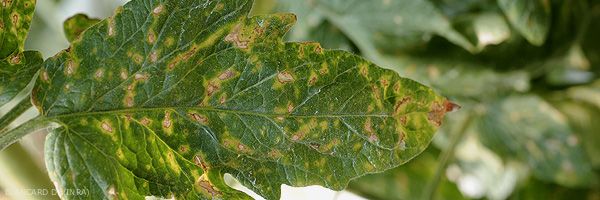
Stemphylium spp.
S. lycopersici (Enjoji) W. Yamam., (1960)
(syn. S floridanum C.I. Hannon & G.F. Weber, (1955)
S. botryosum f. sp. lycopersici Rotem, Y. Cohen & I. Wahl, (1966)
(Anamorph Pleospora plants (Pers.) Rabenh., (1854)
S. vesicarium (Wallr.) E.G. Simmons, (1969)
(syn. Pleospora allii (Rabenh.) Ces. & De Not., (1863)
S. botryosum Sacc., (1886)
- classification : Fungi, Ascomycota, Dothideomycetes, Pleosporomycetidae, Pleosporales, Pleosporaceae
- téléomorphe : Pleospora
- English name: gray leaf spot
This disease globally distributed is particularly serious in humid tropical and subtropical production areas . It is described on the American continent: United States, Canada, Mexico, Brazil, Colombia, Peru ; it is very serious in Cuba. It affects many African countries (Ivory Coast, Gambia, Tanzania, Tunisia, Morocco ) and is less serious in Europe (Germany, Italy, Spain ). Stemphyliosis is also reported in Asia (China, Japan, Indonesia, Thailand ), and Oceania (Australia). It is found both in the open field and under shelters. In France , we observed it only once under shelter, in Vendée, caused by S. vesicarium . It is therefore expressed very rarely in our territory. On the other hand, it is very present in the overseas departments and territories.
The species involved depend on the production areas : S. solani and S. floridanum would rather be subservient to tropical regions while S. botryosum f. sp. lycopersici and S. vesicarium would be found preferentially in areas further north. However, it is possible that several species can occur on tomato in the same country.
In hot and humid conditions, these fungi produce severe damage on susceptible varieties, causing significant defoliations.
Stemphyliosis is a leaf disease of tomatoes , the symptoms of which are classically associated with three different species of Stemphylium : S. solani , S. lycopersici and S. botryosum f. sp. lycopersici . Several identifications carried out in the 1980s, in particular in the Mediterranean Basin, did not allow us to find S. botryosum f. sp. lycopersici . We mainly identified S. vesicarium and demonstrated that this species is pathogenic on tomato. As we will see later, these four Stemphyliums are controlled by the same resistance gene in Lycopersicon esculentum .





